I drive into Conwy – a lovely town, with a maze of narrow streets and a confusing one-way system. Eventually, after several tours of the town, I find a long-stay car park. It seems miles away from the starting point for today’s walk, but I follow signposts along a footpath and am surprised to discover I’m really just below the castle walls.
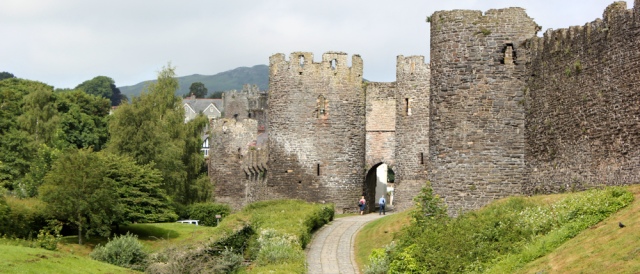
The wonderful old suspension bridge across the river is no longer used, and is sandwiched between a newer traffic crossing and a hideous railway bridge. So I was unable to take a decent photograph but Wikimedia Commons has a great photo of the bridge.
I follow a pleasant footpath / cycle route along the eastern bank of the river, heading back towards the sea.

There are impressive views of Conwy castle on the other side, although I’m not pleased to see dark clouds piling up over the hills.

I reach Deganwy and the path leaves the shore to bypass a new housing estate. Not for the first time I’m irritated by the short-sightedness of town planners. Why allow new developments along the banks of rivers without insisting the contractors provide a proper waterside walking route?
I’m soon back on the shore again, and walk past the back of the railway station.

I reach the mouth of the estuary and the path, bordered by wild flowers, continues winding around a shallow bay towards Llandudno. The Great Orme appears to have grown larger since I saw it from Penmaenmawr. No longer a low island.
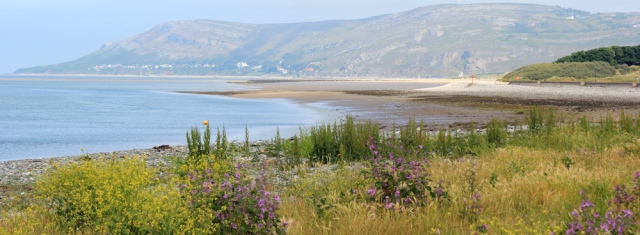
My B&B hosts (in Llanfairfechan) told me that the town of Conwy marks the end of Wales and the Welsh language. I must say they are mainly right, as from now on I rarely hear a word of Welsh spoken. The official signs, however, remain determinedly bilingual.

The sign above warns of the danger of being caught by the tide out on the Conwy Sands. And, just in case you fail to heed the warning, it also says: ‘A rescue raft is located on the highest portion of the sandbank during the months April to October inclusive.’
Further on another sign warns of another danger. Golfers! No Welsh translation provided.

The beach here is beautiful and, although the clouds remain dark behind me, the Great Orme is bright and welcoming. It grows larger every minute.

I spot an orange contraption out on a sandbank. Ah. Is that the ‘rescue raft’? It looks more substantial than I anticipated.

At the foot of the Great Orme I stop beside a breakwater for a rest and a snack. From here the path follows a narrow road around the circumference of the Orme. The Marine Drive. An impressive entrance.

The road climbs slowly. I take a photograph looking back along the beach.

As I climb higher I hear grumbles of thunder. Although I’m walking in sunshine, the hills beyond Conwy – Penmaenbach and Penmaenmawr – are suffering from a thunderstorm. I’m glad I walked that section yesterday and not today!
The storm creates a dramatic landscape across Conwy Sands – golden sand and green water, bordered by black hills under an indigo sky.

Below my road is a collection of houses, strung out along the shore. It’s an area called Y Gogarth (I think) and seems an enclave for the wealthy. The residences are pretty impressive.

The houses are served by a lower road. I was tempted to take that route – following my rule of sticking close to the shore – but thought it would be a dead-end. What I failed to spot on my map was the extensive area of open access land beyond the road. Now, I realise I could have walked down there after all, following a track past some interesting ruins, and then a steep (a very steep) path that zigzags up to rejoin my road.
Too late now. I always regret paths I haven’t taken.
Marine Drive is a one-way road with very little traffic. A couple of tour buses come past, driving very slowly, with passengers craning to look out at the views. I meet a few cyclists. Very few walkers.

And the white animals on the slopes turn out not to be sheep, but beautiful white goats.
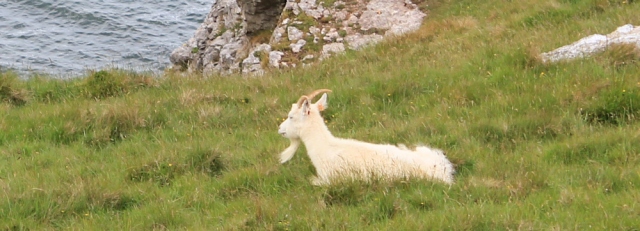
Eventually I reach Great Orme’s Head, the midpoint of the circular route, where there is a welcome sight – a café. Rest and Be Thankful. Lunchtime. I stop and have a cream scone and a thick slice of bara brith.

Apparently on a really clear day you can see Scotland and Ireland from here, as well as England and Wales. Strangely the café windows face inland, instead of out towards the sea. Very odd. Maybe the staff get a better view from the kitchen?
The café has no proper toilets, only portaloos. Luckily I don’t need to go.
From here onwards, the road winds downhill. I meet a couple of cars and one solitary walker. And a sheep. Otherwise I’m alone.

The sunshine has gone and, with dark clouds above, I expect the rain from Conwy to catch up with me at any moment. But it never does.
After an hour or so, I turn a corner and see Llandudno ahead, with its pier.
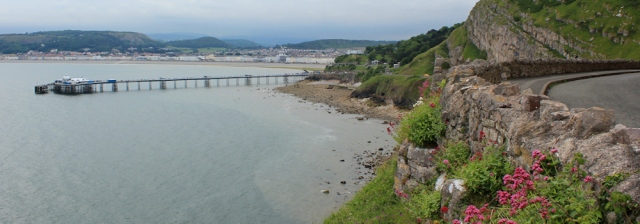
A land train passes me. It seem slightly surreal to meet it, after the isolation of the road before. The driver gives me a cheery wave.
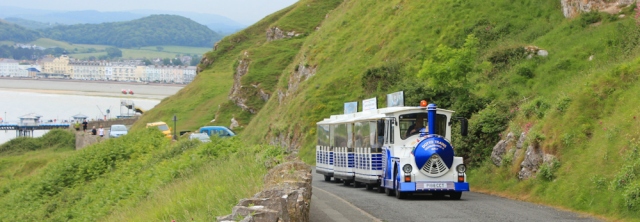
I reach the end of the Marine Drive and another impressive gatehouse. Here I realise why the road is so quiet. It’s a toll road.

Now I’m on the outskirts of Llandudno and walking past a park. I see another one of those modern stone circles, presumably constructed for an Eisteddfod celebration.
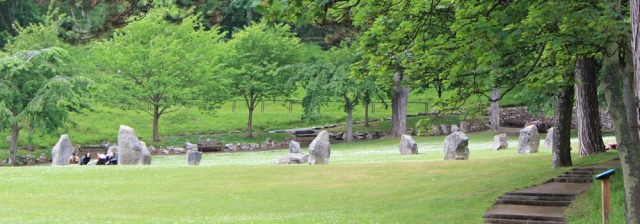
Llandudno pier looks impressive, and I can’t resist taking several photographs. In the back drop is an array of distant wind turbines.

Long ago my family came here on holiday, and one of my brothers baited a fishing line with 10 or so hooks and dropped the line off the end of the pier. He was very young, 12 or 13, and a nearby fisherman had to help him pull the line up. He’d only managed to catch 7 or 8 mackerel!
Later, the hotel we were staying in offered to cook the mackerel for supper and my brother was served one of the fish on a plate. I don’t know what my brother was expecting, but he burst into tears when he saw it. Perhaps it was because the cook had left the head intact?
In my memory, the pier had a standalone entrance, but either my memory is wrong or things have changed. In fact, from the promenade you can’t see the start of pier, as it’s obscured by a collection of rather tacky amusement arcades and shacks.

Otherwise, Llandudno is much as I remembered it. A wide promenade lined by tall houses, most of them hotels or guest houses of some sort. It’s crowded with old people and young families. English northern accents.

I walk around the bay and the further I get the quieter the promenade becomes. I’m pleased to leave the crowds behind. Next stop: the Little Orme.
[To be continued…]







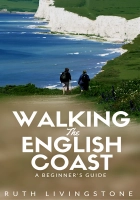
The hideous railway bridge, while admittedly not pretty, is perhaps surprisingly no modern monstrosity. Opened in 1849 and designed by Robert stephenson, it was a working prototyope for the Britannia Bridge across the Menai Strait. In other words, the Britannia Bridge looked like this too until it caught fire in the 70s. The fire, I think, was an aesthetic improvement.
Conwy Castle’s an impressive-looking beats isn’t it? I think its in my all-time top three, along with Caernarfon and Pembroke.
Ahhhh. I wondered how any modern planner would get away with building such an ugly bridge near that beautiful castle. That explains it. Now I’m almost glad the Britannia Bridge caught fire… Thank you for the explanation.
*beast, not beats. Not that a castle is technically either.
I’ve been waiting eagerly for the next post on your walk and you haven’t disappointed me with this one; you’ve got some lovely photos there, and as I’m familiar with all the places you’ve been through or past I feel like I’ve been walking with you.
The hideous tubular railway bridge at Conway was built by Robert Stephenson and was the forerunner to the Britannia bridge across to Anglesey, but as part of that was destroyed by fire in 1970 the one at Conwy is now his only existing work. The suspension bridge is owned and managed by the NT and is still accessible on foot for a small fee – I’ve been meaning for ages to go across it but haven’t got there yet.
The footpath/cycle path from Conwy to Deganwy is one I haven’t explored yet; I love your photo of the castle taken from there. I went to Deganwy itself at Easter three years ago but didn’t stay long as there’s nothing much there, though I did walk through that housing estate to the marina at the far side of it. Your photo of the stormy sky across Conwy Sands is great, I think it looks more like a painting than a photo.
Llandudno is still very much the same as when I was a kid; apart from a large very modern building about halfway along the promenade the hotels and guest houses are all the same as years ago. I remember being on holiday there when I was quite young, we were on the beach with some friends of my parents and their daughter and a seagull flew over and pooped on my dad’s head – I think that’s the only thing I remember about that particular holiday! 🙂
It seems Helpful Mammal beat me to it with the info about the bridge 🙂
It hard to beat that Mammal. He’s fast as well as helpful 😀
Other adjectives are available 😉
Hi Eunice and thank you for your kind words. Although I always love sunny days, stormy weather can create the most wonderful and dramatic landscapes for photography. Of all the resorts I visited on the North Wales Coast, only Llandudno and Conwy had any kind of buzz to them. Llandudno is odd because the best beach is to the south, and yet the main town, and all the hotels, are situated on the north coast.
I’ve always thought of the best beach at Llandudno being to the south but it’s known as West Shore, and when you look at a map it does actually face west. Did you see the White Rabbit statue on the green by the Victorian tram shelter? It was originally situated in the centre of a pond in the gardens across the promenade but was taken away for repairs in 2012 – I went to look for it when I last went there and was disappointed to find it missing. Even as far back as the 1950s it had been vandalised – I remember as a small child seeing it with part of an arm missing – and after further damage in more recent years it ended up with a wrought iron cage round it. It was put in its new location last year after being repaired and cleaned, so hopefully as it’s now situated closer to houses it will remain undamaged.
No, I missed the statue – was probably walking along the beach at the time. Sad story about the vandalism. Don’t understand that attitude. Why spoil something?
“Why allow new developments along the banks of rivers without insisting the contractors provide a proper waterside walking route?” Hear, hear. French or German authorities would surely never allow such a new development in a town or city.
I see many wasted opportunities to improve the local environment. And I have a particular loathing for private estates with gated entrances (this wasn’t one of them – but just want to vent!)
Of course, you can do the Marine Drive more quickly:
A Norwegian and a Finn, common language English. The detail of the pace-notes is remarkable, but probably more than you need for walking!
Ha ha. Enjoyed that, thank you. Even in a fast car it seemed like a long drive. Certainly it seemed like a long walk, but I loved it.
Hello Ruth.. Still following your adventures; you’ve long left the Llyn Peninsula behind and am so impressed with your efforts and “stickability”.. well done you.
This note is as much for others who might follow in your footsteps and to suggest that they take some time out on the Great Orme (Y Gogarth) (Same Arth as in Arthur) to visit the bronze age copper mine.
Uncovered in 1987 during a scheme to landscape an area of the Great Orme, the copper mines discovered represent one of the most astounding archaeological discoveries of recent times. Dating back 4,000 years to the Bronze Age they change our views about the original people of Britain and their civilised and structured society 2,000 years before the Roman invasion.
It was the largest copper mine in the whole of Europe during the Bronze Age, and they mined it for 1500 years so no small local business this; artefacts have been found across mainland Europe, Far East and Middle East, and around most of the Mediterranean.
To quote Francis Pryor, a good East Anglian archaeologist !! “I rate this as possibly the best Pre Roman visitor experience in Britain”
See more here http://www.greatormemines.info/
As I say, for those not just intent on the walk, but may be would want to take a bit more time to discover what lies behind the scenery.
Keep on trecking, and good luck… Brian and Jane Pen Llyn BnB.
I remember you (Brian) telling me about the copper mine and when I saw sign for it I though of you 😀 Sounds an extraordinary place and, yes, excellent advice for other visitors to the area. I’m always slightly ashamed that I don’t spend longer looking at things in the places I visit, but I guess if I did I’d never get much walking done!
Just wanted to say, Ruth, that your photo (“The storm creates a dramatic landscape across Conwy Sands – golden sand and green water, bordered by black hills under an indigo sky.”) is absolutely beautiful. Great photography.
Hi El, it was an amazing landscape. Much of my ‘great’ photography is simply a question of being in the right place at the right time. I always walk with my camera in my hand. 📸
Another lovely walk Ruth. I especially liked all the wildflowers and those views of the storm behind you. So glad it didn’t catch you up too.
I had a charmed few days, Marie, when I could see rain either ahead or behind, but it never fell on me! If only all our walks were so lucky 😀
It was probably busy falling on me! 🙂
The old suspension bridge is a beauty, and Conwy Castle an imposing building. Your photo ‘golden sands and green water’ is breathtaking, and has a painterly look to it. Lovely views and the land train is a delightful sight – very similar to the one at Hengistbury Head.
The wide promenade with its elegant houses is splendid, though too busy for my liking.
Hi, Ruth!
Probably you will find it odd to recieve a comment from Slovenia, but I was visiting Britain on a regular basis back in 1990ties and 2000`s and of course I have many great memories…. but this section of your walk is especially dear to me, I was in Conwy back in 1995 (I think :)) and then walked all the way to Llandudno (which I also find a great place, can not be compared to Colwyn Bay or Rhyl) and then over the Little Orme to Colwyn Bay.
About your blog, I find it terrific! It is my regular read before I go to bed, I normally read 3-4 chapters, together with comments and I simply love it. I even started my own walk (with my misses) here in Slovenia and neighbouring Croatia, which as a wonderful coast) and could one day open my own blog….
Anyway, I wish you all the best, I had great memories on many parts of your walk, because I also walkede Kent, East and West Sussex coast and was down in Devon and Cornwall, too!
Greetings.
Igor Rozman
Koper, Slovenia
Hi Igor, thank you very much for your kind comment, and glad this blog post brought back happy memories. It is a lovely area. I’ve heard Slovenia is very beautiful and Croatia has an amazing coastline, so please let me know if you start your own blog! Best wishes to you and your missus, Ruth